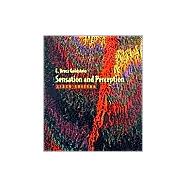Sensation and Perception, Media Edition
, by Goldstein, E. Bruce- ISBN: 9780534639914 | 0534639917
- Cover: Hardcover
- Copyright: 7/14/2003
Part 1: INTRODUCTION TO PERCEPTION. 1. The Psychophysical Approach: Linking Stimulation and Perception. Method of limits. Demonstration, Trial-by-trial method of limits. DL by method of limits, Experiment: Judging differences in size. Measurement Fluctuation and error, Experiment: How accurately can you match size? Adjustment and PSE, Experiment: Length matching. Constant stimuli, Experiment: Judging length. Just noticeable difference, Experiment: Adjust length so just noticeably different. DL vs. Weight, Plot a graph of difference threshold vs. standard stimulus. Weber''s law and Weber fraction, Plot a graph demonstrating Weber''s law. Response compression and expansion, Review different types of magnitude estimation functions. Experiment: Scaling Vision, Magnitude estimation of line length and brightness. 2. The Physiological Approach: Linking Stimulation and Neural Firing. Structure of neuron, Identify parts of a neuron. Oscilloscopes and intracellular recording, Demonstrates oscilloscope measuring resting potential. Phases of action potential, Slide a slider and watch sodium and potassium flow. Nerve impulse coding and stimulus strength, Vary pressure and watch firing rate increase. Synaptic transmission, Identify pre- and post-synaptic neurons and watch nerve firing. Lock and key neurotransmitter action, Drag neurotransmitters to correct sites on membrane. Excitation and inhibition, Vary excitation and inhibition and watch effect on firing rate. Cortical areas, Review location of cortical receiving areas. Part 2: RECEPTORS AND NEURAL PROCESSING. 1. The Stimulus for Vision and the Structure of the Visual System. The Visual Pathways, Identify visual system structures and see animation of signal''s journey from eye to brain. The Human Eye, Identify components of the eye. Cross section of the retina, Identify types of neurons in the retina. 2. The First Transformations: Light, Receptors and Electricity. Visual path within the eyeball, Animation showing electrical signals traveling through the retina and into the optic nerve. 3. Visual Pigments and Perception. Dark adaptation of the rods and cones, Animation of rod and cone adaptation curves. Types of cones, Review cone absorption spectra. 4. Neural Processing by Convergence. Receptor wiring and sensitivity, Demonstrates why rods are more sensitive than cones. Receptor wiring and acuity, Demonstrates why cones have better acuity than rods. 5. Neural Processing By Excitation and Inhibition. Simple neural circuits, Stimulate receptors and notice how different types of circuits work. Mapping receptive fields, Demonstration of center-surround receptive field mapping. Stimulus size and receptive fields, Vary spot size and see how firing rate changes. Receptive fields and stimulus size and shape, Vary bar width and see how firing rate changes. Lateral inhibition, See how increasing lateral inhibition decreases firing rate. Demonstration: Receptive field mapping, Map receptive fields of ganglion cells. 6. Neural Processing and Perception. Lateral inhibition in the Hermann grid, See how lateral inhibition explains the dark spots on the grid. Intensity and brightness, Move slider to see difference between intensity and brightness distributions. Mach bands, See how Mach bands can be explained by receptive fields. Simultaneous contrast, Vary intensities and see how brightness changes in a contrast display. Demonstration: Mach bands - You create intensity distributions. The program calculates perceptual response functions. (Baro InSight demonstration). Part 3: THE LATERAL GENICULATE NUCLEUS AND STRIATE CORTEX. 1. Information Processing in the Striate Cortex (V1). Simple cells in the cortex, See how simple cell firing depends on orientation of a bar. Complex cells in the cortex, See how complex cell firing depends on orientation and direction of movement. Calculating grating contrast, Vary intensities of light and dark bars of a grating. Demonstration: Receptive field mapping - Map receptive






